小升初英语词汇及重点句型
小升初英语必背的句型及词汇归类(最新整理)
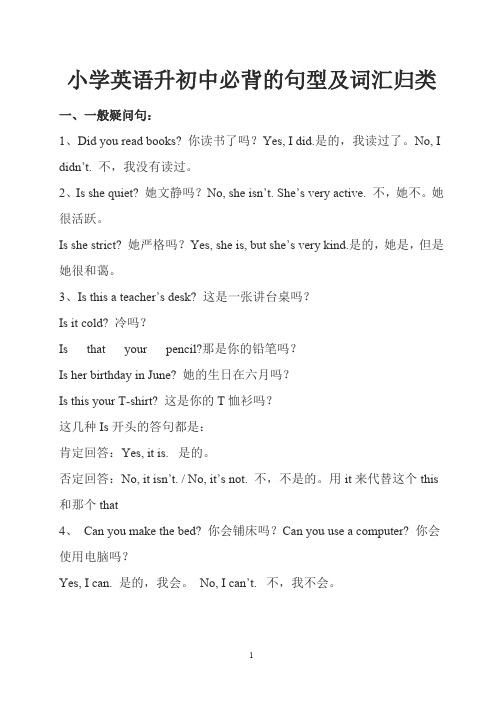
小学英语升初中必背的句型及词汇归类一、一般疑问句:1、Did you read books? 你读书了吗?Yes, I did.是的,我读过了。
No, I didn’t. 不,我没有读过。
2、Is she quiet? 她文静吗?No, she isn’t. She’s very active. 不,她不。
她很活跃。
Is she strict? 她严格吗?Yes, she is, but she’s very kind.是的,她是,但是她很和蔼。
3、Is this a teacher’s desk? 这是一张讲台桌吗?Is it cold? 冷吗?Is that your pencil?那是你的铅笔吗?Is her birthday in June? 她的生日在六月吗?Is this your T-shirt? 这是你的T恤衫吗?这几种Is开头的答句都是:肯定回答:Yes, it is. 是的。
否定回答:No, it isn’t. / No, it’s not. 不,不是的。
用it来代替这个this 和那个that4、Can you make the bed? 你会铺床吗?Can you use a computer? 你会使用电脑吗?Yes, I can. 是的,我会。
No, I can’t. 不,我不会。
5、Are they ducks? 它们是鸭子吗?Are they eating the honey? 它们吃蜂蜜吗?Are those your shoes? 那是你的鞋子吗?Are these your pants? 那是你的裤子吗?这几种句型的回答都是:肯定回答:Yes, they are. 是的,它们是。
否定回答:No, they aren’t. 不,它们不是。
用they来代替这些these和那些those6、Is there a forest in the park? 公园里有一个森林吗?Is there a river?那里有条河吗?Yes, there is. 是的,那里有。
小升初英语常考知识点汇总复习

小升初英语常考知识点汇总复习一、词汇1.介词:- in 在(大、小)、在(年、月、星期)、在(户外活动)- on 在(地图上)、在(表面)、在(大、小)、在(星期和日期)、在(具体场所)- at 在(时刻)、在(大、小)、去(地)- for 为了、给予- with 和谁在一起- to 给予、换- from 来自- of 属于、..的一部分、in the mornig/afternoon/evening- about 关于- on foot 步行2.数词:-数词一般不会单独出现,常与名词搭配使用- 用于询问人数的疑问句: How many + 可数名词复数 + do you have?- 多少用many;几个用a few(可数名词)、a little(不可数名词)- 序数:1st, 2nd, 3rd, 4th...(以th结尾)3.动词:- be动词的三种形式- have的三种形式- 动词的ing形式-祈使句的用法4.名词:- 单数名词变复数的规则:+s, +es, y变i+es-名词所有格的用法5.形容词:- 原级(er)的用法- 比较级(more)的用法- 最高级(most)的用法二、语法1.一般现在时-肯定句、否定句、一般疑问句、特殊疑问句的构成及回答方式2.一般过去时-肯定句、否定句、一般疑问句的构成及回答方式- 常用时间状语:yesterday, last week/month/year, ago3.现在进行时-肯定句、否定句、一般疑问句、特殊疑问句的构成及回答方式- 常用时间状语:now, at the moment, this week/month/year 4.一般将来时-肯定句、否定句、一般疑问句的构成及回答方式- 常用时间状语:tomorrow, next week/month/year5.祈使句-动词原形开头的句子-含义:请求、命令、建议6.特殊疑问句- 特殊疑问词who, what, when, where, why, how的用法-对特殊疑问句的回答7.情态动词- can / can’t- may / may not- must / mustn’t- should / shouldn’t8.语态-被动语态的构成及用法三、阅读理解1.找关键词-定位关键词帮助理解文章-注意定位词的重要性2.标题理解-根据文章内容进行判断-注意段落开始部分的作用四、写作1.简单句的写作-主语+谓语动词+宾语-根据提供的信息进行写作2.描写人物-描述外貌特征、爱好、性格等-句子要表达清楚五、口语1.问候及介绍-问候语及回答-个人信息介绍2.日常用语-表达需求、意愿-赞扬、感谢、道歉-表达喜怒哀乐等情绪。
小升初必考英语知识点总结
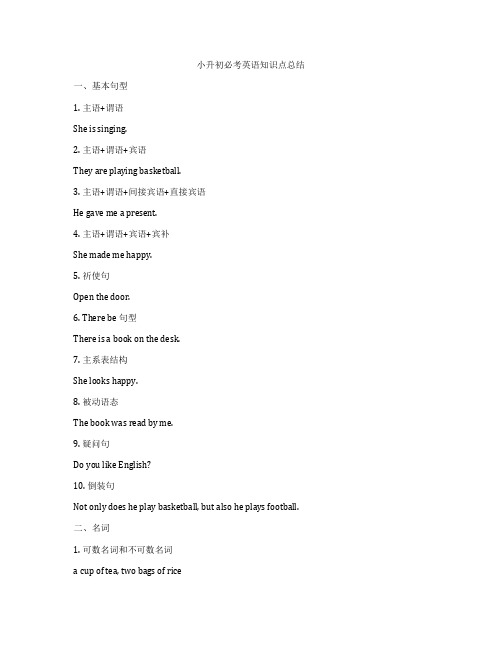
小升初必考英语知识点总结一、基本句型1. 主语+谓语She is singing.2. 主语+谓语+宾语They are playing basketball.3. 主语+谓语+间接宾语+直接宾语He gave me a present.4. 主语+谓语+宾语+宾补She made me happy.5. 祈使句Open the door.6. There be 句型There is a book on the desk.7. 主系表结构She looks happy.8. 被动语态The book was read by me.9. 疑问句Do you like English?10. 倒装句Not only does he play basketball, but also he plays football.二、名词1. 可数名词和不可数名词a cup of tea, two bags of rice2. 名词的所有格my father's car3. 名词的单复数a book, two books4. 特殊名词的复数形式child-children, woman-women5. 特殊名词的不可数名词形式news, information6. 特殊名词的复合名词形式forget-me-not, passer-by三、冠词1. 定冠词和不定冠词a book, the book2. 不加冠词的情况He is a student.3. 特殊用法once upon a time四、代词1. 人称代词I, you, he, she, it, we, they2. 物主代词my, your, his, her, its, our, their3. 反身代词myself, yourself, himself, herself, itself, ourselves, themselves 4. 特殊用法one another, each other五、动词1. 一般现在时He plays basketball every day.2. 一般过去时I played computer games yesterday.3. 一般将来时I will go to the park tomorrow.4. 现在进行时She is reading a book now.5. 过去进行时He was playing basketball at this time yesterday.6. 情态动词can, may, must, should, need7. 动词的不定式to do, to be8. 动词的-ing形式reading, playing9. 动词的完成时I have read that book.10. 动词的被动语态The book was read by me.11. 及物动词和不及物动词I like singing.六、形容词和副词1. 形容词的比较级和最高级big-bigger-biggest2. 副词的用法She sings well.3. 物主形容词my, your, his, her, its, our, their4. 特殊形容词和副词good-better-best, well-better-best七、介词1. in, on, at的用法in the classroom, on the desk, at home2. 特殊介词的用法under, over, between, among3. 介词短语in front of, next to, to the left of4. 介词词组on time, in time八、连词1. and, but, or的用法She likes playing basketball and football.2. because, so的用法He is tired because he works hard.3. 特殊连词的用法either...or, neither...nor, not only...but also...九、数词1. 基数词和序数词one, first2. 特殊数词的用法the first of October, one and a half 3. 特殊用法three times a week, two hours' time十、时间1. 日常时间的表达at seven o'clock, in the morning2. 一般现在时表示的未来情况I leave for Beijing tomorrow.3. 特殊时间状语的用法last Sunday, next Tuesday十一、情态动词1. can, may, must, shouldI can swim.2. 特殊情态动词的用法would like, need3. 特殊用法had better, have to十二、虚拟语气1. if引导的虚拟条件句If I were you, I would go now.2. wish引导的虚拟句I wish I were a bird.3. 特殊用法It's high time, If only十三、疑问句和感叹句1. 一般疑问句Do you like English?2. 特殊疑问句What's your name?3.感叹句What a nice day it is!四、定语和被定语1. 定语的位置和形式the red book, the book on the desk2. 被定语的位置和形式a city of the world, a boy with big eyes3. 特殊用法a cup of tea, the mother of all rivers 十五、主谓一致1. 就近原则Neither she nor I am good at singing.2. 特殊用法There be 句型十六、宾语从句1. 特殊宾语从句的引导词I know who the man is.2. 特殊宾语从句的时态I think he will come soon.十七、主语从句1. 特殊主语从句的引导词What you have said is true.2. 特殊主语从句的时态It's clear that they have won the game. 十八、定语从句1. 特殊定语从句的引导词The boy who is swimming is my friend.2. 特殊定语从句的时态I have lost the pen that you gave me.十九、状语从句1. 时间状语从句When the bell rang, we stopped working.2. 地点状语从句Where there is a will, there is a way.3. 原因状语从句Because he was ill, he didn't go to work.4. 条件状语从句If I were you, I would go now.5. 结果状语从句It's so late that we can't go out.六、语音1. 单词中元音的发音cake, team2. 单词中辅音的发音break, cream3. 单词重读音节的规律beautiful, comfortable4. 特殊音标的发音ai, ee, th七、词汇1. 同义词happy-glad, big-large2. 反义词happy-sad, big-small3. 同音词see-sea, for-four4. 词根act, behave5. 词缀happy-unhappy, Sunday-weekend 8、语法1. 句子成分的转换He doesn't like playing basketball. Playing basketball is not liked by him.2. 句子类型的转换She can swim. - Can she swim?十九、阅读1. 阅读理解阅读短文,回答问题。
小升初英语必背知识点可打印
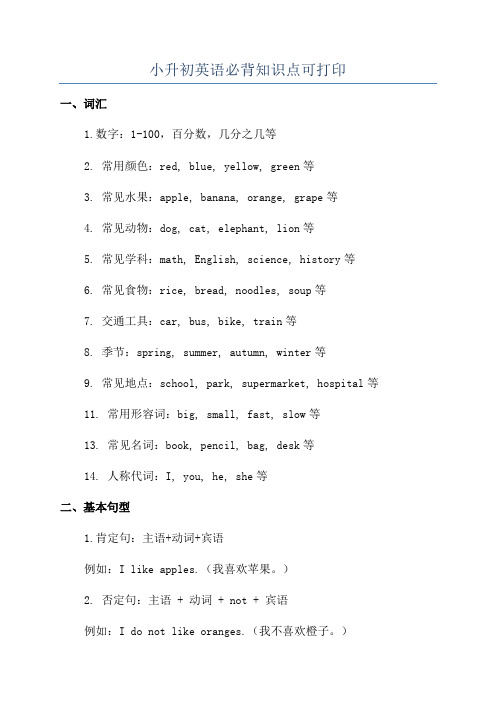
小升初英语必背知识点可打印一、词汇1.数字:1-100,百分数,几分之几等2. 常用颜色:red, blue, yellow, green等3. 常见水果:apple, banana, orange, grape等4. 常见动物:dog, cat, elephant, lion等5. 常见学科:math, English, science, history等6. 常见食物:rice, bread, noodles, soup等7. 交通工具:car, bus, bike, train等8. 季节:spring, summer, autumn, winter等9. 常见地点:school, park, supermarket, hospital等11. 常用形容词:big, small, fast, slow等13. 常见名词:book, pencil, bag, desk等14. 人称代词:I, you, he, she等二、基本句型1.肯定句:主语+动词+宾语例如:I like apples.(我喜欢苹果。
)2. 否定句:主语 + 动词 + not + 宾语例如:I do not like oranges.(我不喜欢橙子。
)3.疑问句:特殊疑问词+助动词/助动词+主语+动词+宾语例如:What do you like?(你喜欢什么?)4.一般疑问句:助动词/助动词+主语+动词+宾语例如:Do you like bananas?(你喜欢香蕉吗?)5. 答语:肯定回答:Yes, 主语 + 动词。
否定回答:No, 主语 + do/does not + 动词。
例如:Yes, I do. / No, I do not.三、时态1. 一般现在时:I/you/we/they + 动词原形,he/she/it + 动词原形 + s/es例如:I like to swim.(我喜欢游泳。
)2.一般过去时:主语+动词过去式例如:They played basketball yesterday.(他们昨天打篮球。
小升初单词、词组、句型、语法大全
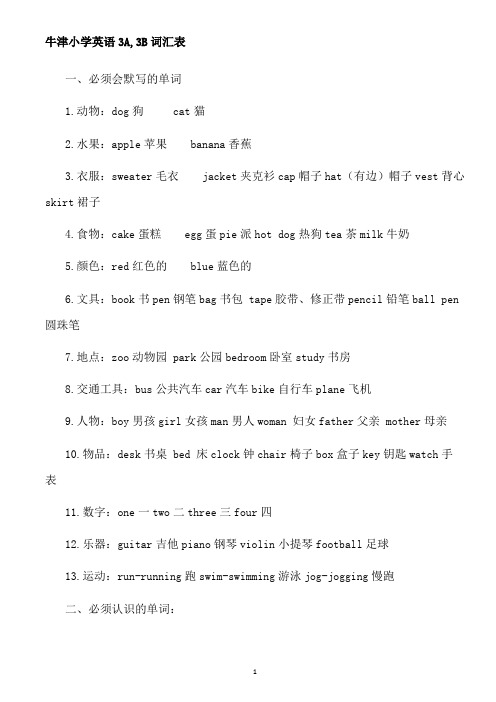
牛津小学英语3A,3B词汇表一、必须会默写的单词1.动物:dog狗 cat猫2.水果:apple苹果 banana香蕉3.衣服:sweater毛衣 jacket夹克衫cap帽子hat(有边)帽子vest背心skirt 裙子4.食物:cake蛋糕 egg蛋pie派hot dog热狗tea茶milk牛奶5.颜色:red红色的 blue蓝色的6.文具:book书pen钢笔bag书包 tape胶带、修正带pencil铅笔ball pen 圆珠笔7.地点:zoo动物园 park公园bedroom卧室study书房8.交通工具:bus公共汽车car汽车bike自行车plane飞机9.人物:boy男孩girl女孩man男人woman 妇女father父亲 mother母亲10.物品:desk书桌 bed 床clock钟chair椅子box盒子key钥匙watch手表11.数字:one一two二three三four四12.乐器:guitar吉他piano钢琴violin小提琴football足球13.运动:run-running跑swim-swimming游泳jog-jogging慢跑二、必须认识的单词:1.家庭成员:grandfather爷爷grandmother奶奶aunt阿姨uncle叔叔brother 兄、弟sister姐、妹son儿子daughter女儿2.文具:storybook故事书copybook抄写本knife小刀crayon蜡笔stapler 订书机3.物品:computer电脑radio收音机camera照相机toy train玩具火车(a toy …)4.数字:five五six六seven七eight八nine九ten十eleven十一twelve 十二 thirteen十三fourteen十四fifteen十五sixteen十六seventeen十七eighteen十八nineteen十九twenty二十twenty-one二十一twenty-two二十二thirty三十forty四十fifty 五十sixty六十seventy七十eighty八十ninety九十ninety-nine九十九5.地点:a dining-room餐厅a kitchen厨房a bathroom卫生间a sitting-room 客厅6.食物:a hamburger汉堡包an ice cream冰淇淋a sandwich三明治some bread 一些面包some rice一些米饭coffee咖啡juice果汁soft drinks软饮料a cup of …一(茶)杯… a glass of …一(玻璃)杯…a bar of chocolate一块巧克力a carton of milk一盒牛奶7.衣服:a coat外套a blouse(女)衬衫a dress连衣裙a shirt(男)衬衫a T-shirt T恤衫a belt皮带shoes鞋子trousers裤子socks袜子a tie领带8.球类:volleyball排球baseball棒球basketball篮球9.乐器:an accordion手风琴10.运动:climb-climbing爬山skate-skating滑冰ski-skiing滑雪rowing 划船fishing钓鱼牛津英语4A、4B词汇——4A词汇表Unit 1 May I have …?四会单词:I我,I’m=I am, yes是,是的a一(个,件…),this这;这个for 给;为you你;你们, pen钢笔,a ball pen圆珠笔,pencil铅笔, book书,May I …?我可以…吗?have 得到三会单词:come in进来Miss女士,小姐(对未婚妇女的称呼),please请, copybook抄写本 ,thank谢谢,sure当然,here这里;这儿,are是,Here you are.给你。
小升初英语必考40个重点知识点
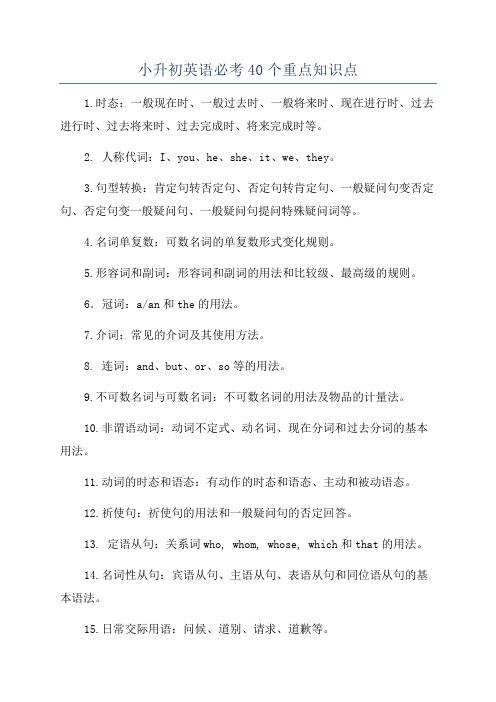
小升初英语必考40个重点知识点1.时态:一般现在时、一般过去时、一般将来时、现在进行时、过去进行时、过去将来时、过去完成时、将来完成时等。
2. 人称代词:I、you、he、she、it、we、they。
3.句型转换:肯定句转否定句、否定句转肯定句、一般疑问句变否定句、否定句变一般疑问句、一般疑问句提问特殊疑问词等。
4.名词单复数:可数名词的单复数形式变化规则。
5.形容词和副词:形容词和副词的用法和比较级、最高级的规则。
6.冠词:a/an和the的用法。
7.介词:常见的介词及其使用方法。
8. 连词:and、but、or、so等的用法。
9.不可数名词与可数名词:不可数名词的用法及物品的计量法。
10.非谓语动词:动词不定式、动名词、现在分词和过去分词的基本用法。
11.动词的时态和语态:有动作的时态和语态、主动和被动语态。
12.祈使句:祈使句的用法和一般疑问句的否定回答。
13. 定语从句:关系词who, whom, whose, which和that的用法。
14.名词性从句:宾语从句、主语从句、表语从句和同位语从句的基本语法。
15.日常交际用语:问候、道别、请求、道歉等。
16.宾语:及物动词后面的宾语和介词后面的宾语。
17.数词:数字和序数词的用法。
18.频率副词:频率副词的位置和用法。
19. 情态动词:can、could、may、might等的用法。
20.反意疑问句:反意疑问句的构成和回答方式。
21.祈使句和陈述句的句型转换。
22.简单句和复合句的句型转换。
23.状语从句:时间、地点、方式等状语从句的用法。
24.英语字母和大小写的用法规则。
25.数字和时间的表达方法。
26.祈使句、感叹句和陈述句的区别。
27.人称代词和形容词性物主代词的用法。
28.祈使句的否定形式的构成和用法。
29.独立主格结构:独立主格结构的基本句型和用法。
30.定语从句和名词性从句的结构和区别。
31.特殊疑问句:特殊疑问句的基本用法和回答方式。
PEP英语小升初知识点归纳

PEP英语小升初知识点归纳(一)短语和词组line up 排列 a long tail 一条长尾巴than you taller 比你高how heavy 多重how long多长how big 多大have a fever 发烧have the flu 患流感a big nose 一个大鼻子have a headache 头痛go to the park 去公园watch TV看电视at night 在夜晚play the piano 弹钢琴play football 踢足球listen to music听音乐go swimming 去游泳wash clothes 洗衣服feel tired 感觉劳累take some medicine 吃药worry about 焦急,担心have a sore throat 喉咙疼have a toothache 牙痛laugh at 因…而发笑eat good food 品尝美食buy present 买礼物take pictures 照相learn Chinese 学汉语folk dance 民族舞folk clothes 民族服装this weekend 这个周末by plane (by air)乘飞机 a taxi driver 出租车司机go skiing去滑雪far from 离….远farewell party欢送会last day of the holiday 假期的最后一天good luck 好运at the museum/airport 在博物馆/飞机场in the future 在将来the end of the school 学年末carrot juice 胡萝卜汁 a book of stamps 一本邮册just a minute 等一会Stone forest 石林Spring city 春城on the moon 在月球funny tongue twisters 有趣的绕口令a few days 几天the deep cold water 在寒冷的深水a pair of 一双theme park 主题公园read a magazine 阅读杂志comic book 漫画书fruit stand 水果摊shoe store鞋店pet shop 宠物商店go to the cinema 去看电影go away 离开go back to school 返回学校go hiking 远足go on a big trip 进行一次长途旅行answer the door 开门answer the phone 接电话answer----answering(现在分词)take off 脱下take a trip 去旅行take---took (过去式) taking(现在分词) takes(单三)do the dishes洗碗碟do morning exercises 晨练do an experiment 做实验did(过去式)do housework 做家务do homework 做作业do—does (单三) doing (现在分词)write a report 写报告write a letter 写信write an e-mail 写电子邮件write a poem 写诗write (writes 单三)(writing现在分词)(wrote 过去式)make a snowman 堆雪人make a kite(make kites) 制作风筝make the bed 整理床铺collect insects 收集昆虫collect stamps 收集邮票collect leaves 收集树叶make sure 确认cook the meals 做饭cook noodles 煮面条catch the ball 接球catch butterflies 捉蝴蝶catch—caught(过去式) catches(单三)交通用语stop at a red light 红灯停wait a yellow light 黄灯等go at a green light 绿灯行by bike 骑自行车on foot 步行by car(take the car)/by subway/ by ship crosswalk人行穿越道No entry禁止通行No bikes自行车禁行One way单行道Turn right 右转No turn left 禁止左转告别语write soon尽快给我回信take care保重have a trip 旅途愉快keep up touch 保持联系see you later 一会见(二)词的用法A.名词复数例:book---books watch—watches baby---babies knife---knives roof--roofs foot---feet man—men goose—geese ox--oxen child—children mouse---mice tomato—tomatoes fish—fish deer—deer Chinese –Chinese Japanese—Japanese woman doctor-----women doctorsB.冠词例:a worker a pen an hour an apple an orange the pictureC.代词例:I(主格)---me(宾格)my(形容词物主代词)-----mine(名词性物主代词) You ----you your ---- yoursHe -----him his ------ hisShe ----her her ------hersWe ---us our ------oursYou ---you your ------yoursThey -- them their -------theirs(注:This is my jacket.(同义句) This jacket is mine.D.数词.基数词one two three four …..序数词first second third fourth fifth eighth ninth twentieth thirty—first(第三十一)F.形容词比较级和最高级例:tall—taller big---bigger heavy—heavier late—later beautiful—more beautiful good/well---better---best(最高级) many/much---more---most(最高级)ill/bad----worse-----worst(最高级) little-------less---------least(最高级)old---older/elder—oldest/eldest(最高级) far—farther/further—farthest/furthest(最高级) 例句:I am taller than your brother. He is shorter than me.(三)英语时态的简单用法A..一般现在时(当主语是单数第三人称时,谓语动词要发生相应的变化,即单三形式)(always usually often sometimes never every day …..这些词出现体现一般现在时)例1.)He always helps others. 他总是帮助别人。
小升初英语重点知识点总结
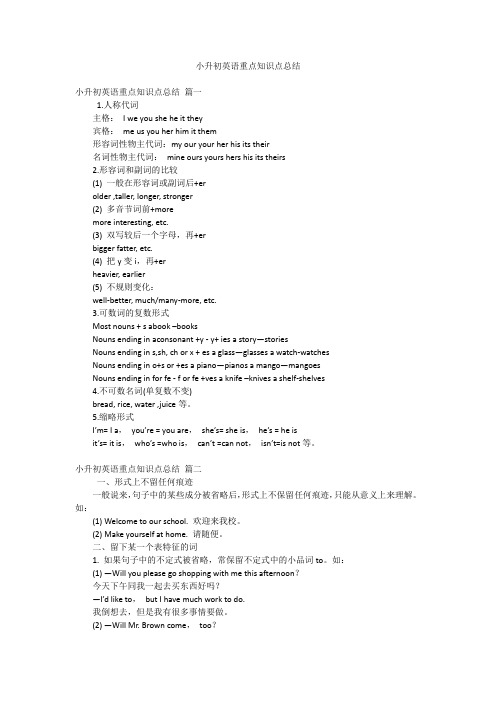
小升初英语重点知识点总结小升初英语重点知识点总结篇一1.人称代词主格:I we you she he it they宾格:me us you her him it them形容词性物主代词:my our your her his its their名词性物主代词:mine ours yours hers his its theirs2.形容词和副词的比较(1) 一般在形容词或副词后+erolder ,taller, longer, stronger(2) 多音节词前+moremore interesting, etc.(3) 双写较后一个字母,再+erbigger fatter, etc.(4) 把y变i,再+erheavier, earlier(5) 不规则变化:well-better, much/many-more, etc.3.可数词的复数形式Most nouns + s abook –booksNouns ending in aconsonant +y - y+ ies a story—storiesNouns ending in s,sh, ch or x + es a glass—glasses a watch-watchesNouns ending in o+s or +es a piano—pianos a mango—mangoesNouns ending in for fe - f or fe +ves a knife –knives a shelf-shelves4.不可数名词(单复数不变)bread, rice, water ,juice等。
5.缩略形式I’m= I a,you’re = you are,she’s= she is,he’s = he isit’s= it is,who’s =who is,can’t =can not,isn’t=is not等。
小升初英语重点知识点总结篇二一、形式上不留任何痕迹一般说来,句子中的某些成分被省略后,形式上不保留任何痕迹,只能从意义上来理解。
2024小升初英语必考语法知识点归纳

2024小升初英语必考语法知识点归纳2024字小升初英语考试是学生们升入初中的重要关卡之一,英语语法是考试重点和难点。
以下是2024小升初英语必考的语法知识点归纳,供同学们参考复习。
一、动词时态1.一般现在时:表示经常性的动作或客观事实。
例如:I go to school every day.2.现在进行时:表示现阶段正在进行的动作。
例如:She is studying English now.3.一般过去时:表示已经完成的过去的动作。
例如:I watched a movie last night.4.过去进行时:表示过去一些时间段正在进行的动作。
例如:They were playing chess this morning.5.将来时:表示将来要发生的动作或存在的状态。
例如:I will go on a trip next week.6.过去将来时:表示过去一些时间节点上将要发生的动作。
二、名词1.可数名词与不可数名词:可数名词有单数和复数之分,不可数名词只有单数形式。
例如:table(可数), water(不可数)2.名词所有格:表示所有关系时,在名词后加's。
例如:Tom's book(汤姆的书)3.复合名词:由两个或两个以上名词构成并有一定结构的名词。
例如:classroom, basketball三、形容词与副词1.形容词用来修饰名词,副词用来修饰动词、形容词或其他副词。
例如:She is a beautiful girl.(形容词修饰名词)He runs fast.(副词修饰动词)2. 形容词的比较级和最高级:一般在形容词后面加-er表示比较级,在形容词前面加the最高级。
例如:He is taller than me.(比较级)He is the tallest boy in our class.(最高级)四、代词1. 人称代词:主格形式有I, you, he, she, it, we, they;宾格形式有me, you, him, her, it, us, them。
小升初英语单词、词组、句型及语法总汇
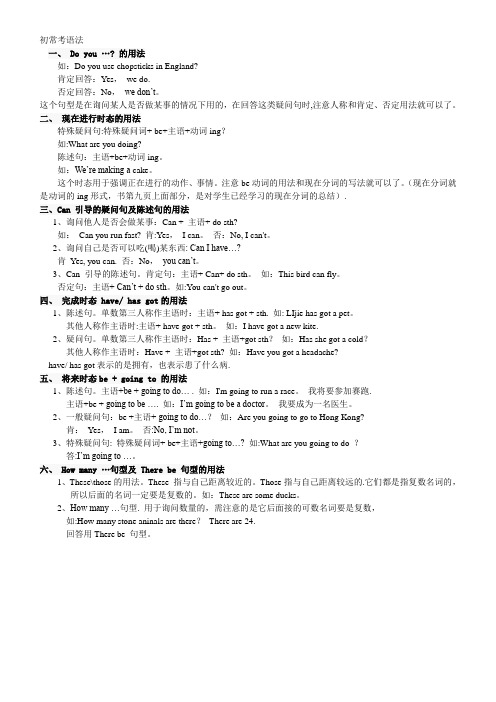
初常考语法一、Do you …? 的用法如:Do you use chopsticks in England?肯定回答:Yes,we do.否定回答:No,we don’t。
这个句型是在询问某人是否做某事的情况下用的,在回答这类疑问句时,注意人称和肯定、否定用法就可以了。
二、现在进行时态的用法特殊疑问句:特殊疑问词+ be+主语+动词ing?如:What are you doing?陈述句:主语+be+动词ing。
如:We’re making a cake。
这个时态用于强调正在进行的动作、事情。
注意be动词的用法和现在分词的写法就可以了。
(现在分词就是动词的ing形式,书第九页上面部分,是对学生已经学习的现在分词的总结).三、Can 引导的疑问句及陈述句的用法1、询问他人是否会做某事:Can + 主语+ do sth?如:Can you run fast? 肯:Yes,I can。
否:No, I can't。
2、询问自己是否可以吃(喝)某东西: Can I have…?肯Yes, you can. 否:No,you can’t。
3、Can 引导的陈述句。
肯定句:主语+ Can+ do sth。
如:This bird can fly。
否定句:主语+ Can’t + do sth。
如:You can't go out。
四、完成时态 have/ has got的用法1、陈述句。
单数第三人称作主语时:主语+ has got + sth. 如: LIjie has got a pet。
其他人称作主语时:主语+ have got + sth。
如:I have got a new kite.2、疑问句。
单数第三人称作主语时:Has + 主语+got sth?如:Has she got a cold?其他人称作主语时:Have + 主语+got sth? 如:Have you got a headache?have/ has got表示的是拥有,也表示患了什么病.五、将来时态be + going to 的用法1、陈述句。
人教版英语三到六年级单词、句型(适合小升初复习资料)

三年级上册单词表Unit1 Hello!1.ruler ['ru:lə] n. 尺子2.pencil [pensl] n. 铅笔3.eraser [i'reisə] n. 橡皮擦;黑板擦4.crayon ['kreiən] n. 蜡笔5.bag [bæg] n.包6.pen [pen] n. 钢笔7.pencil box ['pensl bɔks] n. 铅笔盒8.book [buk] n. 书9.no [nəu] 不10.your [jɔ:ə] pron. 你的,你们的Unit2 Colours1.red [red] n. 红色adj. 红色的1.green [ɡriːn] adj. 绿色的n. 绿色2.yellow [ˈjeləu] adj. 黄色的n. 黄色3.blue [bluː] n. 蓝色adj. 蓝色的4.black [blæk] n. 黑色adj. 黑色的5.brown [braun] n.棕色adj.棕色的6.white [(h)wait] adj. 白色的n. 白色7.orange [ˈɔrindʒ] n. 橙色adj. 橙色的8.Ok [əu’kei] 好;行9.Mum [mʌm] n. 妈妈Unit3 Look at me1.face [feis] n. 脸1.ear [iə] n. 耳朵2.eye [ai] n. 眼睛3.nose [nəuz] n. 鼻子4.mouth [mauθ] n. 嘴5.arm [ɑ:m] n. 胳膊6.hand [hænd] n. 手7.head [hed] n. 头8.body ['bɔdi] n. 身体9.leg [leg] n. 腿10.foot [fut] n. 脚11.School 学校Unit4 We love animals 1.duck [dʌk] n. 鸭子1.pig [piɡ] n. 猪2.cat [kæt] n. 猫3.bear [beəə] n. 熊4.dog [dɔg] n. 狗5.elep hant [ˈ'elifənt] n. 大象6.monkey ['mʌŋki] n. 猴子7.bird [bə:əd] n. 鸟8.tiger ['taigə] n. 老虎9.panda [ˈ'pændə] n. 熊猫10.zoo [zuː] n. 动物园11.Funny 滑稽的,好笑的Unit5 Let's eat!1.bread[bred] n.面包2.juice [dʒu:s] n. 果汁、液3.egg [eg] n. 蛋k [milk] n.牛奶5.water ['wɔ:tə] n. 水6.cake[keik] n. 蛋糕7.fish [fiʃ] n. 鱼8.rice [rais] n. 米饭Unit 6 Happy Birthday!1.one[wʌn] num. 一2.two[tu:] num. 二3.three[θri:] num. 三4.four [fɔ:] num. 四5.five [faiv] num. 五6.six[siks] num. 六7.seven['sevn] num. 七8.eight [eit] num. 八9.nine[nain] num. 九10.ten[ten] num. 十11.brother兄,弟12.plate盘子三年级下册单词表Unit 1UK 英国Canada加拿大USA美国China中国she 她pupil 小学生he他boy [bɔi] 男孩girl [ɡə:l] 女孩teacher ['ti:tʃə] 教师student ['stju:dənt]学生this [ðis, 弱ðəs] 这个my 我的friend [frend] 朋友I’m=I am 我是nice [nais]好的;愉快的good morning ['mɔ:niŋ] 早上好good afternoon [,ɑ:ftə:'nu:n]" 下午好meet [mi:t]遇见;碰见goodbye [,ɡud'bai] 再见too [tu:] 也;太and和,与new新的today今天Unit 2father ['fɑ:ðə] 父亲;爸爸dad 爸爸(口语)mother ['mʌðə]母亲;妈妈mom 妈妈(口语)man [mæn] 男人woman ['wumən]女人grandmother ['ɡrænd,mʌðə] 外祖母grandma ['ɡrændmɑ:](口语(外)祖母grandfather ['ɡrænd,fɑ:ðə](外)祖父grandpa ['ɡrændpɑ:](口语(外)祖父sister ['sistə] 姐妹brother ['brʌðə] 兄妹let’s=let [let] us [ʌs] 让我们great [ɡreit] 太好了really ['riəli, 'ri:li] 真地;确切地and ænd, 和;并且how [hau] 多么;怎么样Unit 3thin 瘦的fat肥的small [smɔl] 小的big [biɡ]大的long [l ɔŋ, lɔ:ŋ] 长的short [ʃɔrt] 短的;矮的tall [tɔ:l] 高的giraffe [dʒə'ræf] 长颈鹿deer [diə] 鹿so这么,那么children (child的复数)小孩tail尾巴Unit 4on在......上in 在......里under 在......下chair椅子desk书桌cap帽子ball球car汽车boat船map地图toy玩具box盒子,箱子Unit 5peach [pitʃ]桃pear [pεə]梨orange ['ɔrindʒ] 橙子watermelon ['wɔtɚ,mɛlən]西瓜apple ['æpl] 苹果banana [bə'nænə] 香蕉strawberry ['strɔbɛrɪ]草莓grape [ɡreip]葡萄buy 买fruit水果Unit 6eleven [i'levən] 十一twelve [twelv] 十二thirteen 'θə:'ti:n] 十三fourteen ['fɔ:'ti:n]十四fifteen ['fifti:n] 十五sixteen ['siks'ti:n] 十六seventeen [,sevən'ti:n] 十七eighteen ['ei'ti:n] 十八nineteen [,nain'ti:n] 十九twenty ['twenti] 二十how [hau] many ['meni]多少can [kæn, kən] 能够;可以look [luk] at [强æt, 弱ət]看;瞧kite 风筝beautiful美丽的四年级上册单词表Unit 1classroom [ˈklɑ:sru:m] 教室window [ˈwindəu] 窗户blackboard [bɔ:d] 黑板light [lait] 电灯picture [ˊpiktʃə] 图画door [dɔ:] 门teacherˊs desk [ˈti:tʃəz desk]讲台computer [kəmˊpju:tə] 电脑fan [fæn] 风扇wall [wɔ:l] 墙floor [flɔ:] 地板Unit 2s choolbag [ˈsku:lˌbæg] 书包math [mæθ] book[buk] 数学书English [ˊiŋglɪʃ] book[buk] 英语书Chinese [tʃaiˊni:z] book[buk] 语文书story-book [ˊstɔ:ri buk] 故事书candy [kændi] 糖果notebook [ˊnəutbuk] 笔记本toy [tɔi] 玩具key [ki ] 钥匙Unit 3strong [strɔŋ] 强壮的friendly [frendli] 朋友(们)quiet [ˊkwaiət] 安静的hair [hɛə]头发shoe [ʃu: ] 鞋glasses [gla:siz]眼镜Unit 4bedroom [ˈbedˌru:m, -ˌrʊm] 卧室living room [ˈliviŋ ru:m]起居室study [ˊstʌdi] 书房kitchen [ˊkitʃin] 厨房bathroom [ˊbɑ:θrum] 卫生间bed [bed] 床phone [fəun] 电话table [ˊteibl] 桌子sofa [ˊsəufə] 沙发fridge [fridʒ] 冰箱Unit 5beef [bi:f] 牛肉chicken [ˊtʃikin] 鸡肉noodle(s) [ˊnu:dl(s)] 面条soup [su:p] 汤vegetable [ˊvedʒitəbl] 蔬菜chopstick [ˈtʃɔpˌstɪk]筷子bowl [bəul ] 碗fork [fɔ:k] 叉子knife [naif] 小刀spoon [spu:n] 勺子dinner [ˊdinə] 晚餐;正餐Unit 6parents [ˊpɛərənts] 父母cousin 同辈表亲或堂亲uncle [ˊʌŋkl] 叔叔;舅舅叔父;伯父;姨夫aunt [英] [ɑ:nt] 姑姑;婶;姨baby [ˊbeibi] 婴儿doctor [ˊdɔktə] 医生cook [ˊkuk] 厨师driver [ˊdraivə] 司机farmer [ˊfɑ:mə] 农民nurse [nə:s] 护士四年级下册单词表Unit 1first floor 一楼second floor 二楼teacher’s office 教师办公室library 图书馆playground 操场computer room 计算机房art room 美术教室music room 音乐教室next to 紧邻;在……近旁homework 作业class 班;班级forty四十,way方向Unit 2breakfast 早餐;早饭English class英语课lunch 午餐;午饭music class 音乐课PE class 体育课dinner (中午或晚上吃的)正餐get up 起床go to school 去上学go home 回家go to bed 上床睡觉over 结束o’clock (表示整点)……点钟kid小孩thirty三十,hurry快点come快,加油just 稍等一会Unit 3cold 寒冷的;冷的cool 凉的;凉爽的warm 温暖的;暖和的hot 热的;烫的sunny 阳光充足的windy 多风的;风大的cloudy 阴天的;多云的snowy 下雪(多)的rainy 阴雨的;多雨的weather 天气New York 纽约how about ……怎么样?……情况如何?degree 度;度数world 世界London 伦敦Moscow 莫斯科Singapore 新加坡城Sydney 悉尼fly 放(风筝等)love(写信结尾的热情问候)爱你的Unit 4tomato 西红柿potato 马铃薯;土豆green beans 豆角;四季豆carrot 胡萝卜horse 马cow 母牛;奶牛sheep 羊;绵羊hen 母鸡these (this的复数形式)yum (表示味道或气味非常好)animal 兽;动物those (that的复数形式)那些garden 花园;菜园farm 农场goat 山羊eat 吃Unit 5clothes 衣服;服装pants 裤子hat (常指带檐的)帽子dress 连衣裙skirt 女裙coat 外衣;大衣sweater 毛衣sock 短袜shorts 短裤jacket 夹克衫shirt (尤指男士)衬衫yours 你的;你们的whose 谁的mine 我的pack 收拾(行李)wait 等待Unit 6glove(分手指的)手套scarf 围巾;披巾umbrella 伞;雨伞sunglasses 太阳镜pretty 美观的;精致的expensive 昂贵的;花钱多的cheap 花钱少的;便宜的nice 好的try on 试穿size 尺码;号of course 当然too 太;过于just 正好;恰好how much 多少钱eighty 八十dollar元sale特价销售;大减价more 更多的us 我们五年级上册单词表Unit 1old[əuld]年老的young [jʌŋ]年轻的funny ['fʌni]滑稽可笑的.kind[kaind]和蔼的strict[strikt]严格的polite[pəˈlaɪt]有礼貌的;有教养的hard-working[hɑ:d 'wɜ:kɪŋ]努力工作的,勤奋helpful[’helpfl]有帮助的clever[’klevə(r)]聪明的,聪颖的shy [ʃaɪ] 害羞的;腼腆的finish英[ˈfɪnɪʃ] 完成;做完Unit 2Monday(Mon.)星期一['mʌndei]Tuesday(Tue.)星期二['tju:zdei] Wednesday(Wed.)星期三['wenzdei] Thursday(Thu.)星期四['θə:zdei]Friday(Fri.)星期五['fraidei]Saturday(Sat.)['sætədei]星期六Sunday(Sun.) ['sʌndei]星期天.weekend [ˌwi:kˈend]周末wash my clothes 洗我的衣服do homework ['həumwə:k] 做作业read books 看书play football 踢足球often [ˈɒfn] 常常;时常park [pɑ:k] 公园play sports 做体育运动Unit 3sandwich [ˈsænwɪtʃ] 三明治salad [ˈsæləd] 蔬菜沙拉;混合沙拉hamburger [ˈhæmbɜ:gə(r)] 汉堡ice cream [aɪs kri:m] 冰淇淋tea [ti:] 茶水;茶fresh [freʃ]新鲜的healthy['helθi]健康的;有益健康的delicious [dɪˈlɪʃəs] 美味的,可口的hot [hɒt] 辣的;辛辣的sweet [swi:t]甜的drink [drɪŋk]喝;饮thirsty [ˈθɜ:sti] 渴的口渴的favourite ['feivərit]特别喜爱的;最喜爱的food [fu:d] 食物Dear[dɪə(r)] 亲爱的Unit 4sing [sɪŋ]唱;song [sɒŋ]歌曲sing English songs 唱英文歌曲play the pipa弹琵琶kung fu [kʌŋ fu] 功夫武术do kung fu 练武术dance [dɑ:ns] 跳舞draw[drɔ:] 画cartoon [kɑ:ˈtu:n]漫画draw cartoon 画漫画cook [kʊk] 烹调swim [swɪm] 游泳play basketball 打蓝球ping pong [pɪŋ pɔŋ]乒乓球运动play ping-pong 打乒乓球speak English 说英语party [ˈpɑ:ti]聚会;派对Unit 5clock [klɒk] 钟,时钟plant [plɑ:nt]植物bottle [ˈbɒtl]瓶子water bottle 水瓶bike [baɪk] 自行车photo [ˈfəʊtəʊ] 照片;相片front [frʌnt] 正面in front of 在……前面between [bɪˈtwi:n] 在…之间;above [əˈbʌv] 在……上面beside [bɪˈsaɪd]在…旁边(附近)behind [bɪˈhaɪnd]在…的后面Unit 6forest ['fɔrist]森林river ['rivə]河流lake [leik]湖泊mountain ['mauntin]高山;山脉hill [hɪl] 小山tree [tri:]树;树木bridge [bridʒ]桥building ['bildiŋ]建筑物village ['vilidʒ]乡村;村庄house [haus]房子;住宅boating [’bəʊtɪŋ]划船go boating 去划船五年级下册单词表Unit 1eat breakfast 吃早饭have … class上……课play sports 进行体育运动exercise 活动;运动do morning exercises 早锻炼eat dinner 吃晚饭clean my room 打扫我的房间go for a walk 散步go shopping 去买东西;购物take 学习;上(课)dancing 跳舞;舞蹈take a dancing class 上舞蹈课when 什么时候;何时after 在(时间)后usually 通常地;惯常地a.m. 午前;上午p.m. 午后;下午why 为什么always 总是,一直go swimming 去游泳Spain 西班牙start开始late晚,迟shop 购物work工作last上一个的,刚过去的sound听起来好像busy忙的also 也,还need需要play戏剧,剧本letter信live 居住island岛always总是,一直cave山洞,洞穴win获胜Unit 2spring 春天summer 夏天autumn 秋天winter 冬天season 季节picnic 野餐go on a picnic 去野餐pick 摘;采集pick apples 摘苹果snowman 雪人make a snowman 堆雪人go swimming 去游泳which 哪一个best 最好地snow 雪good job做得好because 因为vacation 假期all 全,完全pink粉红色lovely可爱的leaf树叶(复数为leaves)fall 落下;【美】秋天paint 用颜料画Unit 3January 一月February 二月March 三月April 四月May 五月June 六月July 七月August 八月September 九月October 十月November 十一月December 十二月plant 种植Easter 复活节trip 旅行national 国家的National Day 国庆日American 美国的Thanksgiving 感恩节Christmas 圣诞节Great Wall 长城holiday 假日;节日game游戏riddle 谜,谜语act扮演act out把......表演出来RSVP(尤用于请柬)请赐复by在.....之前Unit 4first (1st)第一的second (2nd)第二的third (3rd)第三的fourth (4th)第四的fifth (5th)第五的twelfth (12th)第十二的twentieth (20th)第二十的twenty-first (21st)第二十一的twenty-third (23rd)第二十三的thirtieth (30th)第三十的special特殊的,特别的show展览festival节日kitten小猫diary日记still依旧,仍然noise 噪音fur(某动物的)浓厚的软毛open 开着的walk行走Unit 5mine我的yours你(们)的his他的hers她的theirs他们的,她们的,它们的ours我们的climbing (climb的-ing形式)(正在)攀登;eating(eat的-ing形式)(正在)吃playing(play的-ing形式)(正在)玩耍jumping(jump的-ing形式)(正在)跳drinking(drink的-ing形式)(正在)喝(水)sleeping(sleep的-ing形式)(正在)睡觉each other 相互excited 兴奋的;激动的like 像……那样Unit 6doing morning exercises(正在)做早操having... class(正在)上......课eating lunch(正在)吃饭reading a book(正在)读书listening to music(正在)听音乐keep 保持某种状态keep to the right 靠右keep your desk clean保持你的课桌干净turn 顺序take turns 按顺序来bamboo 竹子its 它的show 给人看anything任何事物else 另外,其他exhibition展览,say 说, 讲have a look看一看,sushi 寿司teach 教sure (表示同意)当然Canadian,加拿大的Spani sh西班牙的六年级上册单词表science科学museum博物馆post office邮局bookstore书店cinema电影院hospital医院crossing十字路口turn left左转go straight笔直走turn right右转sir先生Italian意大利的restaurant餐馆get到达map地图compass 指南针GPS定位系统follow跟着far远next to 与......相邻near在......附近feature 特点, gave give的过去式, tell告诉on foot步行by 经,乘bus公共汽车plane飞机taxi出租车ship大船subway地铁slow down减速train火车stop停,停车站foot脚traffic交通traffic lights交通信号灯bike自行车fast快的ferry轮渡sled 雪橇must必须wear穿, early 早的, helmet头盔, pay attention to 注意交通方式:on foot步行by bus乘公共汽车by bike骑自行车by plane乘飞机by taxi 坐出租车by ship乘轮船by subway坐地铁by sled坐雪橇by ferry轮渡visit 拜访visit my grandparents拜访我的祖父母film电影see a film 看电影trip旅行take a trip去旅行supermarket超市go to the supermarket去超市this morning今天早上this afternoon今天下午this evening今天晚上tonight今晚next week下周dictionary词典comic滑稽的comic book儿童连环画word单词word book单词书postcard明信片lesson课space travel太空旅游, half一般, price价格, Mid-Autumn Festival中秋节, together一起, get together聚会, mooncake月饼, poem诗, moon月亮like+动词ing形式。
小升初英语复习重点汇总

小升初英语复习重点汇总小升初英语复习重点汇总学好初中的英语知识,可以为将来高中英语的学习打下结实的基础,减少学习负担。
下面是小编为大家整理的小升初英语复习重点,欢迎阅读,希望对大家有所帮助。
小升初英语复习重点1:主要不定代词的用法:(1)one的用法A. one作为代词可以指人,也可以指物。
B. one,ones (one的复数形式) 可用来代替前面出现过的少数名词,以避免重复。
C. one的前面可用this,that,the,which等词来修饰。
D. 常有a+形容词+one这一形式。
it和one的用法区别:it用来指特定的东西,而one则用于替代不特定的东西。
(2)some和any的用法区别A. some,any可与单、复数可数名词和不可数名词连用。
some 一般用于肯定句,any一般用于否定句,疑问句和条件句中。
B. some,any与—thing,—body,—one构成的合成词的用法与some,any一样。
C.在疑问句中,一般不用some,只有当问句表示一种邀请或者请求,或期待一个肯定的回答时才能用some。
D. some在否定句中表示半否定,any表示全否定。
E.some用于单数可数名词前,表示“某个”而不是“一些”。
(3)other,another的用法数种类单数复数泛指another=an otherother (boys)others特指the otherthe other (boys) the others 功能作主语、宾语、定语作定语作主语、宾语 A. another=anotherI want to have another two cakes.我想再吃两个蛋糕。
B.the other表示两个中的另一个,常与one连用。
常见形式是“one...the other...”。
C. other+复数名词=othersD. the other+复数名词=the others(4) a11、both的用法 both表示“两者都……”,而a11表示“三个或三个以上的人或物都……”。
小升初英语必考10个知识点归纳总结

小升初英语必考10个知识点归纳总结英语中的一些语法是考试中必考的,同学们你知道这些知识点吗?小编已经帮你总结好啦!1.动词be(is,am,are)的用法我(I)用am,你(you)用are,is跟着他(he),她(she),它(it)。
单数名词用is,复数名词全用are。
变否定,更容易,be后not加上去。
变疑问,往前提,句末问号莫丢弃。
还有一条须注意,句首大写莫忘记。
2.this,that和it用法(1)this和that是指示代词,it是人称代词。
(2)距离说话人近的人或物用this, 距离说话人远的人或物用that。
如:This is a flower. 这是一朵花。
(近处)That is a tree. 那是一棵树。
(远处)(3)放在一起的两样东西,先说this, 后说that。
如:This is a pen. That isa pencil. 这是一支钢笔。
那是一支铅笔。
(4)向别人介绍某人时说This is…, 不说That is…。
如:This is Helen. Helen, this is Tom. 这是海伦,海伦,这是汤姆。
(5)This is 不能缩写, 而That is可以缩写。
如:This is a bike. That’s a car. 这是一辆自行车。
那是一辆轿车。
(6)打电话时,介绍自己用this, 询问对方用that。
如:-Hello! Is that Miss Green? 喂,是格林小姐吗?-Yes, this is. Who’s that? 是的,我是,你是谁?注意:虽然汉语中使用“我”和“你”,但英语中打电话时绝不可以说:I am…, Are you…?/Who are you?(7)在回答this或that作主语的疑问句时, 要用it代替this或that。
如:①-Is this a notebook? 这是笔记本吗?-Yes, it is. 是的,它是。
小学英语小升初重点短语句型语法汇总
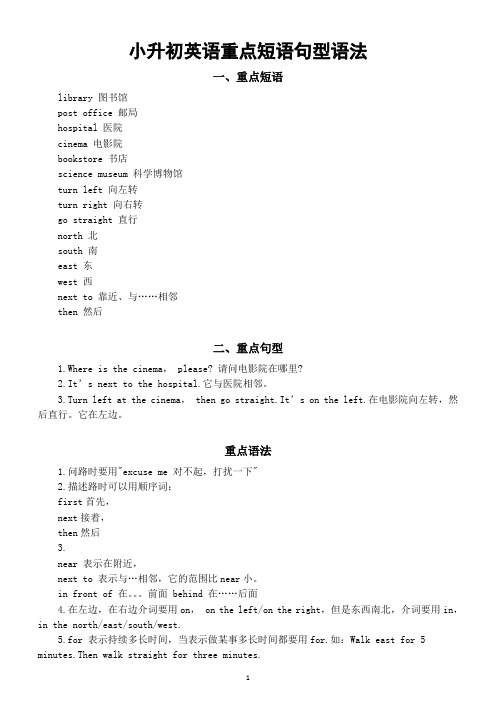
小升初英语重点短语句型语法一、重点短语library 图书馆post office 邮局hospital 医院cinema 电影院bookstore 书店science museum 科学博物馆turn left 向左转turn right 向右转go straight 直行north 北south 南east 东west 西next to 靠近、与……相邻then 然后二、重点句型1.Where is the cinema, please? 请问电影院在哪里?2.It’s next to the hospital.它与医院相邻。
3.Turn left at the cinema, then go straight.It’s on the left.在电影院向左转,然后直行。
它在左边。
重点语法1.问路时要用"excuse me 对不起,打扰一下"2.描述路时可以用顺序词:first首先,next接着,then然后3.near 表示在附近,next to 表示与…相邻,它的范围比near小。
in front of 在。
前面 behind 在……后面4.在左边,在右边介词要用on, on the left/on the right,但是东西南北,介词要用in,in the north/east/south/west.5.for 表示持续多长时间,当表示做某事多长时间都要用for.如:Walk east for 5 minutes.Then walk straight for three minutes.6.乘几路车可以用by the No.301 bus,注意No.中N要大写,后面要加点。
如果要用动词可以用take,例如take the No.301 bus.7.当表示某个地方在另一个地方的哪一方向时,要用介词of。
如:the hospital is east of the cinema.医院在电影院的东边。
小升初英语语法大全与必背知识点
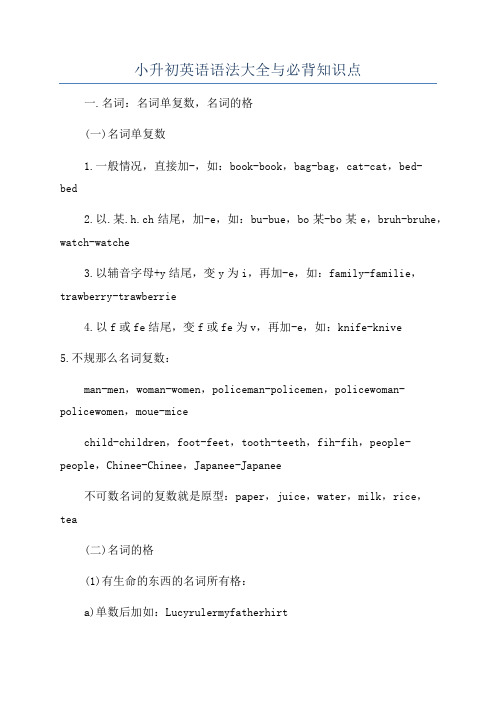
小升初英语语法大全与必背知识点一.名词:名词单复数,名词的格(一)名词单复数1.一般情况,直接加-,如:book-book,bag-bag,cat-cat,bed-bed2.以.某.h.ch结尾,加-e,如:bu-bue,bo某-bo某e,bruh-bruhe,watch-watche3.以辅音字母+y结尾,变y为i,再加-e,如:family-familie,trawberry-trawberrie4.以f或fe结尾,变f或fe为v,再加-e,如:knife-knive5.不规那么名词复数:man-men,woman-women,policeman-policemen,policewoman-policewomen,moue-micechild-children,foot-feet,tooth-teeth,fih-fih,people-people,Chinee-Chinee,Japanee-Japanee不可数名词的复数就是原型:paper,juice,water,milk,rice,tea(二)名词的格(1)有生命的东西的名词所有格:a)单数后加如:Lucyrulermyfatherhirtb)以结尾的复数名词后加如:hifriendbagc)不以结尾的复数后加childrenhoe并列名词中,如果把加在最后一个名词后,表示共有,如:TomandMikecar汤姆和迈克共有的小汽车要表示所有物不是共有的,应分别在并列名词后加TomandMikecar汤姆和麦克各自的小汽车(2)表示无生命东西的名词通常用of+名词来表示所有关系:如:apictureoftheclaroomamapofChina二.冠词:不定冠词,定冠词种类:(1)不定冠词:a/anaunit/anuncle元音开头的可数名词前用an:anegg/anapple/anorange/aneraer/ananwer/anIDcard/analarmclock /anactor/anactre/ane-mail/anaddre/anevent/ane某ample/anopera/anhouranoldman/aninteretingbook/ane某citingport/anactionmovie/anartleon/(2)定冠词:thetheeggtheplane2.用法:定冠词的用法:(1)特指某(些)人或某(些)物:Therulerionthedek.(2)复述上文提到的人或物:Hehaaweater.Theweaterinew.(3)谈话双方都知道的人或物:Theboyarentatchool.(4)在序数词前:JohnbirthdayiFebruarytheecond.(5)用于固定词组中:inthemorning/afternoon/evening不用冠词的情况:(1)专有名词前:Chinaiabigcountry.(2)名词前有定语:thi,that,my,your,ome,any,no等:Thiimybaeball.(3)复数名词表示一类人和事:Monkeycantwim.Theyareteacher.(4)在节日,日期,月份,季节前:TodayiChritmaDay.ItSunday.(5)一日三餐前:Wehavebreakfatat6:30.(6)球类棋类运动前:Theyoftenplayfootballaftercla.Heplaycheathome.某但乐器前要用定冠词:Iplaytheguitarverywell.(7)学科名称前:Myfavoriteubjectimuic.(8)在称呼或头衔的名词前:ThiiMrLi.(9)固定词组中:atnoonatnightbybu三、代词:人称代词,物主代词人称代词物主代词主格宾格第一人称单数I(我)memy(我的)复数we(我们)uour(我们的)第二人称单数you(你)youyour(你的)复数you(你们)youyour(你们的)第三人称单数he(他)himhi(他的)he(她)herher(她的)it(它)itit(它的)复数they(他们/她们/它们)themtheir(他们的/她们的/它们的)四、形容词,副词:比较级,最高级(一)、形容词的比较级1、形容词比较级在句子中的运用:两个事物或人的比较用比较级,比较级后面一般带有单词than。
小学英语小升初复习重点知识汇总(共39类)
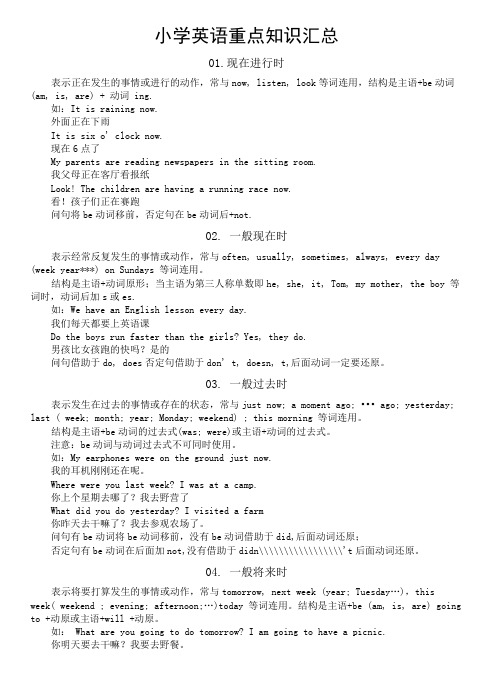
小学英语重点知识汇总01.现在进行时表示正在发生的事情或进行的动作,常与now, listen, look等词连用,结构是主语+be动词(am, is, are) + 动词 ing.如:It is raining now.外面正在下雨It is six o' clock now.现在6点了My parents are reading newspapers in the sitting room.我父母正在客厅看报纸Look! The children are having a running race now.看!孩子们正在赛跑问句将be动词移前,否定句在be动词后+not.02. 一般现在时表示经常反复发生的事情或动作,常与often, usually, sometimes, always, every day (week year***) on Sundays 等词连用。
结构是主语+动词原形;当主语为第三人称单数即he, she, it, Tom, my mother, the boy 等词时,动词后加s或es.如:We have an English lesson every day.我们每天都要上英语课Do the boys run faster than the girls? Yes, they do.男孩比女孩跑的快吗?是的问句借助于do, does否定句借助于don' t, doesn, t,后面动词一定要还原。
03. 一般过去时表示发生在过去的事情或存在的状态,常与just now; a moment ago; ••• ago; yesterday; last ( week; month; year; Monday; weekend) ; this morning 等词连用。
结构是主语+be动词的过去式(was; were)或主语+动词的过去式。
注意:be动词与动词过去式不可同时使用。
小升初英语重点单词、短语、句子整理归纳

小升初英语重点单词、短语、句子整理归纳一、单词Unit 1学习文具:pen (钢笔) pencil (铅笔) pencil-case ( 铅笔盒) ruler(尺子) eraser(橡皮) crayon (蜡笔) book (书) bag (书包) sharpener (卷笔刀) school (学校)Unit 2身体部位:head (头) face( 脸) nose (鼻子) mouth (嘴) eye (眼睛) leg (腿) ear (耳朵) arm (胳膊) finger (手指) leg (腿) foot (脚) body (身体)Unit 3颜色:red (红色的) yellow (黄色的) green (绿色的) blue (蓝色的) purple (紫色的) white (白色的) black (黑色的) orange (橙色的) pink (粉色的) brown (棕色的)Unit 4动物:cat (猫) dog (狗) monkey (猴子) panda (熊猫) rabbit( 兔子) duck (鸭子) pig (猪) bird (鸟) bear (熊) elephant (大象) mouse (老鼠) squirrel (松鼠)Unit 5食物:cake (蛋糕) bread (面包) hot dog (热狗) hamburger (汉堡包)chicken (鸡肉) French fries (炸薯条) coke (可乐) juice (果汁) milk (牛奶) water (水) tea (茶) coffee (咖啡) Unit 6数字:one (一) two (二) three (三) four (四) five (五) six( 六) seven (七) eight (八) nine( 九) ten( 十) doll (玩具娃娃) boat (小船) ball (球) kite (风筝) balloon (气球) car (小汽车) plane (飞机)二、对话1、向别人问好应该说A: Hello! (你好!)B: Hi! (你好!)2、问别人的名字应该说A:What's your name? 你的名字是什么?B:My name's Chen Jie. 我的名字是陈洁。
小升初英语重点语法和句型
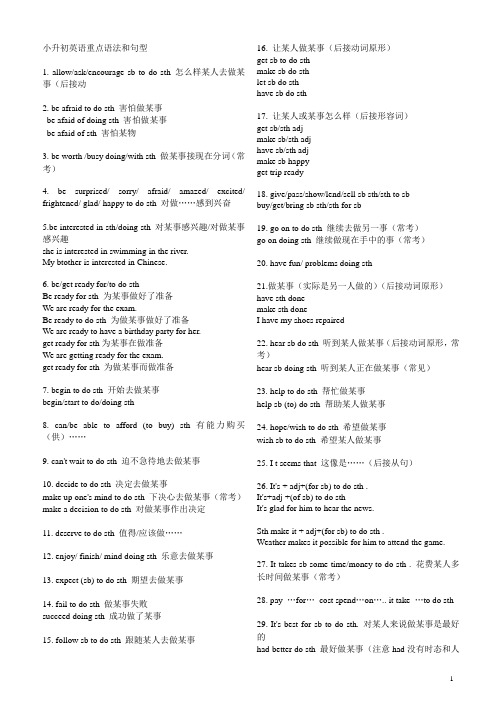
小升初英语重点语法和句型1. allow/ask/encourage sb to do sth 怎么样某人去做某事(后接动2. be afraid to do sth 害怕做某事be afaid of doing sth 害怕做某事be afaid of sth 害怕某物3. be worth /busy doing/with sth 做某事接现在分词(常考)4. be surprised/ sorry/ afraid/ amazed/ excited/ frightened/ glad/ happy to do sth 对做……感到兴奋5.be interested in sth/doing sth 对某事感兴趣/对做某事感兴趣she is interested in swimming in the river.My btother is interested in Chinese.6. be/get ready for/to do sthBe ready for sth 为某事做好了准备We are ready for the exam.Be ready to do sth 为做某事做好了准备We are ready to have a birthday party for her.get ready for sth为某事在做准备We are getting ready for the exam.get ready for sth 为做某事而做准备7. begin to do sth 开始去做某事begin/start to do/doing sth8. can/be able to afford (to buy) sth 有能力购买(供)……9. can't wait to do sth 迫不急待地去做某事10. decide to do sth 决定去做某事make up one's mind to do sth 下决心去做某事(常考)make a decision to do sth 对做某事作出决定11. deserve to do sth 值得/应该做……12. enjoy/ finish/ mind doing sth 乐意去做某事13. expect (sb) to do sth 期望去做某事14. fail to do sth 做某事失败succeed doing sth 成功做了某事15. follow sb to do sth 跟随某人去做某事16. 让某人做某事(后接动词原形)get sb to do sthmake sb do sthlet sb do sthhave sb do sth17. 让某人或某事怎么样(后接形容词)get sb/sth adjmake sb/sth adjhave sb/sth adjmake sb happyget trip ready18. give/pass/show/lend/sell sb sth/sth to sbbuy/get/bring sb sth/sth for sb19. go on to do sth 继续去做另一事(常考)go on doing sth 继续做现在手中的事(常考)20. have fun/ problems doing sth21.做某事(实际是另一人做的)(后接动词原形)have sth donemake sth doneI have my shoes repaired22. hear sb do sth 听到某人做某事(后接动词原形,常考)hear sb doing sth 听到某人正在做某事(常见)23. help to do sth 帮忙做某事help sb (to) do sth 帮助某人做某事24. hope/wish to do sth 希望做某事wish sb to do sth 希望某人做某事25. I t seems that 这像是……(后接从句)26. It's + adj+(for sb) to do sth .It's+adj +(of sb) to do sthIt's glad for him to hear the news.Sth make it + adj+(for sb) to do sth .Weather makes it possible for him to attend the game.27. It takes sb some time/money to do sth . 花费某人多长时间做某事(常考)28. pay …for…cost spend…on….. it take …to do sth29. It's best for sb to do sth. 对某人来说做某事是最好的had better do sth 最好做某事(注意had没有时态和人称的变化,better后接动词原形)30. It's time for sb to do sth 是某人做某事的时候了31. keep (on)doing sth 坚持做某事(常考)keep sb doing sth 让某人做某事(常考)keep sb from doing sth 阻止某人做某事(常考)keep sb/sth +adjkeep the book for 2 days 借这本书两天(不要用borrow 或lend)32. learn to do sth 学做某事learn sth from sb 向某人学习33. like to do/doing sth 喜欢做某事like sb to do sth 喜欢某人做某事34. prefer to do sth rather than do sth 宁愿……而不愿……(常考)prefer doing sth to doing sth 喜欢做……胜过做……I prefer reading books to going shopping. 比起购物来,我更爱读书。
小升初英语毕业考必备四会单词与句型

这篇关于⼩升初英语毕业考必备四会单词与句型,是特地为⼤家整理的,希望对⼤家有所帮助!Unit 1 ⼀、四会单词和短语 by[bai] 乘…, foot[fut]脚, bike[baik]⾃⾏车, bus[b s]公共汽车, train[trein]⽕车, how[hau]怎样, traffic[tr fik]交通, wait[weit]等待,stop[st p]停;停车站, get to[get tu]到达, go to school [g tu sku:l]上学, traffic light[tr fik lait]交通灯, traffic rule[tr fik ru:l]交通规则 ⼆、三会单词和短语 plane飞机, ship船, subway地铁, then然后, always总是, know知道 三、⼆会单词和短语 fifth第五, remember记住, find找到, difference不同, same相同的, every每个, country国家, mean意思是, drive驾驶, right side右边, England英国, Australia澳⼤利亚, however但是, left左边的, if如果, must必须 四、四会句⼦ How do you go to school? 你怎样去上学? Usually I go to school on foot. Sometimes I go by bike. 通常我步⾏去上学。
有时候我骑⾃⾏车。
How can I get to Zhongshan Park? You can go by the No.15 bus. 我怎样去中⼭公园?你可以乘⼗五路公共汽车。
五、新学⾳标 /p/ /b/, /t/ /d/, /i:/ /i/。
小升初英语必考知识点总结大全

小升初英语必考知识点总结大全一、基础语法知识点:1.名词:单数形式和复数形式的变化规则,特殊名词复数形式的变化规则。
2.代词:人称代词、物主代词、不定代词的用法。
3. 动词:be 动词的用法、一般现在时和一般过去时的变化规则,动词的原形、第三人称单数形式和过去式的变化规则。
4.形容词和副词:形容词和副词的比较级和最高级的变化规则。
5.介词:表示时间、地点和方式的常用介词的用法。
6.冠词:不定冠词和定冠词的用法。
7.句子结构:主语和谓语的组成,主语和宾语的位置。
8.句子种类:陈述句、疑问句、祈使句的基本结构。
9.简单句和复合句:简单句和复合句的基本结构和连接方法。
二、常用词汇和表达:1.数字和日期:从1到100的数字表达,年、月、日的表达。
2.常见国家和国籍:常见国家的英语表达,常见国籍的英语表达。
3.日常活动:早晨起床、上学、吃饭、洗澡、睡觉等日常活动的英语表达。
4.食物和饮料:常见食物和饮料的英语表达。
5.学习用品和学科:常见学习用品和学科的英语表达。
6.家庭成员和人物角色:常见家庭成员和人物角色的英语表达。
7.动物和植物:常见动物和植物的英语表达。
8.交通工具和地点:常见交通工具和地点的英语表达。
9.身体部位和感觉:常见身体部位和感觉的英语表达。
三、常用句型和句式:1.一般现在时句型:主语+动词原形+其他成分。
2.一般过去时句型:主语+动词过去式+其他成分。
3. 现在进行时句型:主语+be动词+动词ing形式+其他成分。
4. 一般将来时句型:主语+will+动词原形+其他成分。
5. There be 句型:There is/are + 名词 + 地点。
6.一般疑问句句型:助动词+主语+动词原形+其他成分?7.特殊疑问句句型:特殊疑问词+助动词+主语+动词原形+其他成分?8.主从复合句句型:主句+从句。
四、常用语法题型和解题技巧:1.名词和代词题型:单数形式和复数形式的选择,人称代词的选择,不定代词的选择等。
- 1、下载文档前请自行甄别文档内容的完整性,平台不提供额外的编辑、内容补充、找答案等附加服务。
- 2、"仅部分预览"的文档,不可在线预览部分如存在完整性等问题,可反馈申请退款(可完整预览的文档不适用该条件!)。
- 3、如文档侵犯您的权益,请联系客服反馈,我们会尽快为您处理(人工客服工作时间:9:00-18:30)。
2018年小升初英语短语词汇go to the park 去公园climb trees 爬树Be quiet 保持安静Do not touch 不要摸No eating and drinking 禁止吃喝keep off the grass 不践踏草坪No parking 禁止停车No littering 禁止扔杂物from Japan 来自日本No smoking 禁止吸烟at once 立刻,马上his family 他的家人in a week 在一周内feel ill 感觉病了eight subjects 八门课eight lessons 八节课welcome back to school 欢迎回到学校what subjects 什么科目her students 她的学生the first lesson 第一节课wrong number 打错电话on Monday morning 在星期一上午a new term 新学期Monday morning 星期一上午open your mouth 张开你的嘴go to see a doctor 去看医生open your mouth 去看医生have a good rest 好好休息a bad cough 严重的咳嗽take some medicine 吃药after lunch 午饭以后stay in bed 呆在床上the same hobby 相同的爱好a telephone call 一次电话通话in the garden 在花园里water the flowers 浇花animal stamps 动物邮票cook food 做饭show…to… 出示…给…看grow flowers 种花Ben’s hobbyBen 的爱好some hobbies 一些爱好make clothes 做衣服wash clothes 洗衣服collect Chinese stamps 收集中国邮票many beautiful stamps 许多漂亮的邮票go shopping 购物collect stamps 收集邮票dance beautifully 跳舞跳得美take photos 拍照2018小升初小学英语高频重点句型【1-5】1、as…as 和……一样中间必须用形容词或副词原级。
例如:This classroom is as big as that one. 这间教室和那间一样大。
He runs as fast as Tom. 他和汤姆跑的一样快。
否定结构:not as/so…as,“不如……”上面的两个句子可分别改为:This classroom is not as/so large as that one.这间教室不如那间大。
He doesn‘t run as/so fast as Tom.他跑得不如汤姆快。
2、as soon as 一……就…… 用来引导时间状语从句。
若主句是一般将来时,从句要用一般现在时。
例如:I’ll tell him the plan as soon as I see him.我一看到他就告诉他这个计划。
He‘ll go home as soon as he finishes his work.他一完成工作就回家。
3、be busy/enjoy/hate/go on/finish doing sth. 忙于/喜欢/讨厌/ 继续/完成做某事在enjoy, finish, hate, go on, be busy 等词语后,一般用动词-ing 形式作宾语。
例如:Lin Tao is busy making a model plane.林涛正忙着做飞机模型。
My mother enjoys taking a walk after supper.我妈妈喜欢晚饭后散步。
I hate watching Channel Five.我讨厌看五频道。
When someone asked him to have a rest, he just went on working.当有人让他休息一会儿时,他仍继续工作。
I have finished writing the story. 我已经写完了故事。
4、fill…with 用……装满......;be filled with充满了……;be full of 充满了......①be filled with 说明由外界事物造成的此种状态,表示被动。
例如:The box is filled with food.盒子里装满了食物。
②be full of 说明主语处于的状态。
此外,还可表示程度,意为“非常”。
例如:The patient‘s room is full of flowers. 那个病人的房间摆满了花。
The young man is full of pride. 那个年轻人非常骄傲。
③这两种结构还可以相互改写。
例如:I fill the box with food. The box is full of food.5、be good/bad for 有利于/有害于……此句型是:be+adj.+for+n.结构。
例如:Doing morning exercises is good for your health.做早操对你的健康有益。
Always playing computer games is bad for your study.总玩电脑游戏对你的学习不利。
6、be used to(doing) sth. 习惯于…… 后必须接名词或动名词,可用于现在、过去、将来的多种时态be 可用get,become 来代替。
例如:He is used to life in the country.(He is used to living in the country.) 他习惯于乡村生活。
He will get used to getting up early. 他将会习惯于早起。
注意:be used to do 的意思是“被用来做……”。
例如: Wood is used to make paper. 木材被用来造纸。
7、both…and…两者都…… 用来连接两个并列成分;当连接两个并列主语时,其后谓语动词用复数。
例如:Both the students and the teachers will go to the History Museum tomorrow. 不论老师还是学生明天都会去历史博物馆。
8、can‘t help doing sth. 禁不住做某事help 在此的意思是“抑制,忍住”,其后接动词-ing 形式。
例如:His joke is too funny. We can’t help laughing. 他的笑话太有趣了,我们禁不止笑了起来。
9、sth. costs sb. some money 某物花费某人多少钱此句型的主语是物。
cost一词带的是双宾语,它的过去式、过去分词和原型一样。
This book cost me five yuan. 这本书花了我五元钱。
10、either…or… 不是……就是……,或者……或者……用来连接两个并列成分,当连接并列主语时,谓语动词与邻近的主语保持一致。
You may either stay here or go home.你可以呆在这儿,也可以回家。
Either she or I am right. = Either I or she is right.不是她对就是我对。
11、enough (for sb.) to do sth. 足够……做……在此结构中,for 用来引出不定式的逻辑主语。
例如:The ice isn‘t thick enough for you to walk on.这冰还没有厚到你可以在上面走的程度。
12、feel like doing sth. 想要做……此处 like 为介词,后面跟动词-ing 形式。
此句型与 would like to do sth.同义。
例如:I feel like drinking a cup of milk. 我想喝一杯牛奶。
13、feel/find/think it adj./n. to do sth. 认为某事……在此结构中 it 为形式宾语,不定式短语作真正的宾语例如:I find it very interesting to play football.我发现踢足球很有趣。
She thinks it her duty to help us.她认为帮助我们是她的职责。
14、get ready for sth./ to do sth.get ready for sth.意为“为某事做准备”get ready to do sth.意为“准备做某事”例如:We are getting ready for the meeting.我们正在为会议做准备。
They were getting ready to have a sports meet at that moment. 他们那时正准备开运动会。
15、get/receive/have a letter from 收到……的来信,相当于 hear from例如:Did you receive a letter from John?你收到约翰的来信了吗?I got a letter from my brother yesterday.我昨天收到了我弟弟的一封来信。
2018小升初英语高频重点句型【6-10】16、had better (not) do sth. (别)做某事had better 为情态动词,其后需用动词原形。
had better 常用缩写,变成‘d better,其否定形式是在其后直接加 not。
例如:We had better go now. = We’d better go now.我们现在走吧。
You‘d better not go out because it is windy.今天刮风,你别出去了。
17、have sth. done 使(某事)完成 (动作由别人完成)sth.为宾语,done 为过去分词作补语。
例如:We had the machine repaired.我们请人把机器修好了。
注意区分:We have repaired the machine.我们(自己)已经修好了机器。
18、help sb. (to) do sth./with sth. 帮助某人(做)某事其中的 to 可以省略。
例如:I often help my mother with housework.我常常帮助妈妈做家务。
